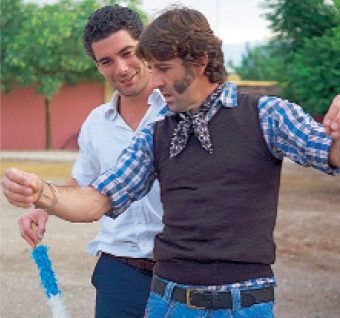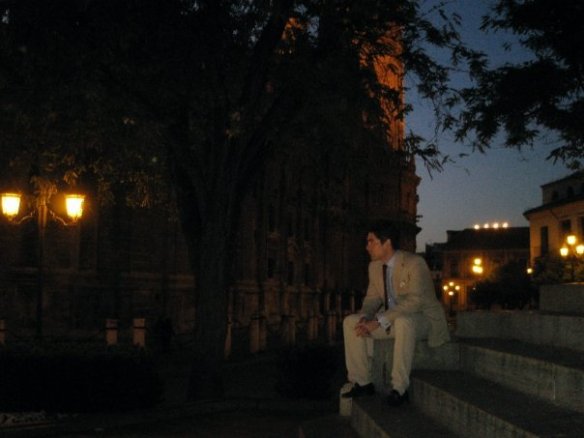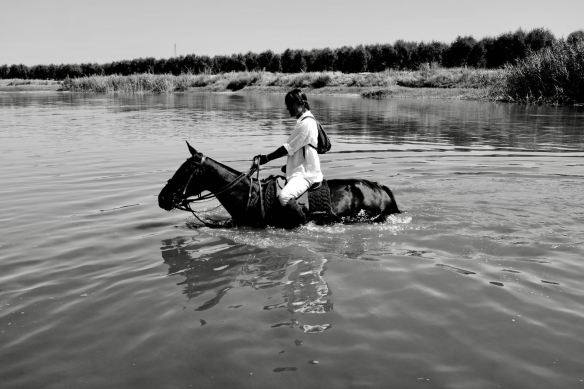Having spent the early part of the summer writing the second edition of the Wallpaper* City Guide: Madrid for Phaidon Press, I thought it worth reminding people that I did the same for their guidebook to Seville in 2014.
These guidebooks tend towards the modern – unsurprising given that Wallpaper* magazine is design led – but I have always found a way to include establishments which aren’t defined by their youth, but by their quality.
Seville – where I have been coming for 20 years – has its finest month in September, especially this year with the 20th Biennial of Flamenco opening on September 7th in la Plaza de Toros de la Real Maestranza, the great bullring – the oldest of its kind in Spain – and running shows throughout the month – some for free – everywhere from the grand Teatro Lope de Vega and the Royal Gardens of the Alcázar Palace to the Church of San Luis de la Franceses to Café Alameda.
Then, on the 29th, in that same ring, the most famous bullfighter in Spain, the one-eyed Juan José Padilla, is fighting his last ever bull as a professional. And this is no washed up matador making a last stand, he was ranked number one in Spain when he made the decision to retire last year, and has triumphed across the country on his final tour. (In Pamplona when I saw him he was extraordinary.)
I’ll write more about this further down this post – he is a personal friend and mentor after all – but to make it easier, I’ll say here that, tickets for that Saturday’s corrida are available to purchase and print online from the English-language version of the official site of the bullring by clicking here. (Tip: you want to sit as close to the centre of the ring, i.e. the sand, as possible, and preferably in the sombra, ‘shade’, or sol y sombra, ‘sun’ that becomes shade as the evening progresses.) The other matadors that day and the next are all extraordinarily talented – and ranked in the top ten for what that’s worth.
Returning to tourism in Seville, for some people, myself included, culinary Spain is exemplified by its ham, and the finest of that is their jamón ibérico de bellota. The best, and most famous, place for it in Seville – at least since 1870 – has been Bar Las Teresas, which sits on the corner of Calle Santa Teresa in Barrio de Santa Cruz, formerly La Judería – ‘The Jewish Quarter’ – of the casco antiguo, the ‘old city’.
Rafael there cuts the ham so well he has won national awards. (The skill and technique are not just to make it thin, but to take the correct amount subcutaneous and intramuscular fat along with the flesh to add flavour and smooth out the texture, as well as feathering the slice so maximum surface area meets the taste buds and also allows rapid heat exchange to evaporate the flavoursome oils into the nasal cavity.)

Rafael cutting at Las Teresas, on the walls are photos of clients from Jackie and Ted Kennedy to Arturo Perez-Reverte, author of the Captain Alatriste novels (Photo: AFH)
What is most important, though, is that the meat is from the ham – the hind leg – of pure-bred black Iberian pigs, ibéricos, also referred to as pata negra, as their hooves are black. (Serrano ham is from ordinary white-hooved pigs, usually from the Duroc or related breeds. Of the 50 million pigs in Spain – more than the population of people at 46.5 million! – a tiny minority are pura raza iberica.)
The hundreds of thousands of Euros worth of legs hanging in Las Teresas are of the very highest quality from the famous town of Jabugo 65 miles north-west of Seville. There the pigs are released at ten months old to free range and forage the dehesa forest floor of the Sierra de Aracena and Picos de Aroche National Park. They feed upon the bellotas, ‘acorns’, from the four species of oak to be found there which allow an acorn season extending from September to March, before they are slaughtered and their meat cured for a minimum of three years.
The jamón is best accompanied – by the glass – at Las Teresas by Emilio Moro’s red wine from Ribera del Duero, served at cellar temperature 55°F/13°C in defiance of the Spanish sun.
It is worth saying that two of the finest hotels are also in this area, the cutting edge boutique that is Hotel Corral del Rey on the street of the same name which belongs to and is run by brothers, Patrick & Anthony Reid, and the labyrinthine and aristocratic beauties of Hotel Las Casas de la Judería, on calle Santa María la Blanca, which belongs to the Duke and Duchess of Segorbe and is run by their ever-charming daughter Doña Luna Medina y Orléans-Braganza.
And whilst you are in that part of town, if you want an introduction to historic flamenco the tablao spectacle at Los Gallos on Plaza de Santa Cruz is both the oldest and the finest of its type in Seville, with its 90 minute shows beginning at 8:30pm and 10:30pm every day. (When I reviewed all these flamenco tablaos for the Financial Times a few years back it stood out not only for the quality of its dancers – which these shows centre on – but the acoustics of the building which mean singers and guitarist did not need amplification and recorded music was out of the question.)
 Another option for tapas is near the extraordinary Gothic grandeur of the world’s largest cathedral, and the beauties of the Royal Palace and Gardens of the Alcázar which rival Granada’s Alhambra. Diego is Rafael’s counterpart and rival at Casa Morales – which has twenty years on Las Teresas – on calle García de Vinuesa.
Another option for tapas is near the extraordinary Gothic grandeur of the world’s largest cathedral, and the beauties of the Royal Palace and Gardens of the Alcázar which rival Granada’s Alhambra. Diego is Rafael’s counterpart and rival at Casa Morales – which has twenty years on Las Teresas – on calle García de Vinuesa.
The jamón there is excellent as well, although their speciality for me is lomo al jerez, a different cut of the same animal served on bread and drizzled with the most incredible olive oil. This should be consumed with a glass of Fernández de Piérola as Diego himself suggests.
While in that part of the town, if you are out of time or sympathy for the bullfights themselves, you can still visit La Maestranza, the most historic of rings – on the Paseo Colón beside the river – and its museum. Or walk along to the Museum of Fine Arts with its historic painting collection on the Plaza del Museo, open 9am-8pm, except Sunday when it closes at 3pm, and Monday when it is closed altogether.
The best place to stay around there, and some say in all Seville, is the Starwood Group’s old school, five-star, palatial Hotel Alfonso XIII on calle San Fernando. It has hosted me on everything from family holidays – to see my first ever corrida in 2000 – to photoshoots for ¡Hola! magazine, although it can become a little corporate at the wrong time of year.
(Whilst in that part of town you can also drop into Casa Matias on calle Arfe and say hello to Matías, unless he is singing, and Emilio behind the bar. It is wonderfully throwback to an older, darker Seville, all wood and dust with a moth-eared but still formidable bull’s head on the wall, and some of the finest spontaneously sung flamenco you will ever hear after the guitarists start to drop from around 6pm on.)
 Returning to the bulls, I launched our book, The Bulls Of Pamplona, during that city’s Fiestas of San Fermín in July. I co-wrote and edited it, and my co-authors include the Mayor of Pamplona, John Hemingway – grandson of Ernest – Beatrice Welles – daughter of Orson (great aficionados of both the bulls and the city), along with the great American runner Joe Distler who has run there since 1968, the Texan rodeo champion Larry Belcher who also ran there for forty years, a tactical and strategic breakdown of the run today by the extraordinary young runner Dennis Clancey, former Captain of the 101st Airborne Division and Iraq veteran, as well as tips and pointers by the great Basque and Spanish runners like Julen Madina, Miguel Ángel Eguiluz and Jokin Zuasti, and photos by the European Pressphoto Agency – and before that Reuters – senior photographer Jim Hollander, who when not embedded in half the wars around the world ran the bulls in the ’60s and ’70s until he was put in hospital by two Miura bulls in 1977 and returned to photograph every Fiesta since. (This year was, in fact, his 50th Fiesta, so his photos are being exhibited by City Hall in the Palace of the Constable, the same space where a few days later Joe Distler received his award for “Foreigner of the Year”, which Jim had received the year before.)
Returning to the bulls, I launched our book, The Bulls Of Pamplona, during that city’s Fiestas of San Fermín in July. I co-wrote and edited it, and my co-authors include the Mayor of Pamplona, John Hemingway – grandson of Ernest – Beatrice Welles – daughter of Orson (great aficionados of both the bulls and the city), along with the great American runner Joe Distler who has run there since 1968, the Texan rodeo champion Larry Belcher who also ran there for forty years, a tactical and strategic breakdown of the run today by the extraordinary young runner Dennis Clancey, former Captain of the 101st Airborne Division and Iraq veteran, as well as tips and pointers by the great Basque and Spanish runners like Julen Madina, Miguel Ángel Eguiluz and Jokin Zuasti, and photos by the European Pressphoto Agency – and before that Reuters – senior photographer Jim Hollander, who when not embedded in half the wars around the world ran the bulls in the ’60s and ’70s until he was put in hospital by two Miura bulls in 1977 and returned to photograph every Fiesta since. (This year was, in fact, his 50th Fiesta, so his photos are being exhibited by City Hall in the Palace of the Constable, the same space where a few days later Joe Distler received his award for “Foreigner of the Year”, which Jim had received the year before.)
We sold out of the book in a single event, although it is very much available online at Amazon: US here, UK here, Spain here etc. etc. Our friend, famed journalist of CBS and CNN Kimberley Dozier, wrote about it in her piece for The Daily Beast.

Alexander Fiske-Harrison with the great Spanish bullfight journalist José Antonio del Moral and Kimberley Dozier at the Pamplona launch of his book The Bulls Of Pamplona (Photo: Anna Nelubova)
Whilst there I felt duty bound to run in some encierros, ‘bull-runs’, and they were as I wished them to be, each time running alongside the great dark mountains in motion that are the toros bravos. My vanity and pride no longer stretch to running in front and pretending to lead them, for in Pamplona this is a myth: the bulls are led perfectly well by the steers and pastores, ‘herdsmen’ (unless one becomes the killing machine that is a suelto, a ‘loose one’, who no longer has a herd, but that is another matter. As is the reality in other, smaller, bull-running towns.)
In fact, this year it was largely a game of trying not to fall over, and when I did fall not to cause further injury to those I fell upon. Like the poor chap I am straddling below between two waves of bulls and whose head was in a pool of blood – I later discovered all his front teeth had been knocked out on the street rather than anything more serious – so when I landed I was desperately trying not to put my hands on what I thought was a fractured skull.

AFH bottom centre selecting where to put his hand to minimise damage to the injured runner beneath him as the last bull comes up the street

Screenshot from video during a ‘family day’ of grandchildren of the ganadero (with the exception of AFH, pictured) at El Grullo, the finca, ‘farm’, of Joaquín Nuñez del Cuvillo, the number one ranked breeder of fighting bulls in Spain.
However, I am now becoming once again more general in my practical interest in the bulls. So I am not just running with bulls – last year saw me run more than two dozen of encierros in a dozen towns – but also back in the ring doing the infinitely more complicated thing of standing in front of the bulls with a piece of red cloth, la muleta. Admittedly the animals are much smaller, but given the mistakes you make that is the only way to learn if you want to walk afterwards (or make it the hour drive to the hospital if the horn goes in.)
This year I have skipped mu usual slew of smaller runs like Tafalla and Falces, San Sebastián de los Reyes and the oldest of all runs, Cuéllar (1215 A.D., and where I will return next year for their own ‘International Figure of the Year’ award.) I did write an article on these less famous encierros and sueltas, which happen in a quarter of Spain’s towns, for the Club Taurino of New York’s magazine reprinted at The Pamplona Post here.

AFH with Juan José Padilla at his home in 2009 (Photo: Nicolás Haro – for The Times magazine‘s feature on us by Giles Coren)
However, I will make one more taurine dash this year, tomorrow in fact, alongside Larry Belcher and the great journalist of bulls (and other matters) Chapu Apaolaza, who is now the spokesman for the Fundación Toro de Lidia, ‘Foundation of the Fighting Bull’, the industry body with whom I now work. He also wrote probably the best solo-author book on why one runs and why it is so much more than just an adrenaline rush. This is not jumping out of a plane, although it does perhaps have something in common with some of the more spiritual conceptions of surfing with their near religious view of the sea. Translated into English by Larry, Three Prayers For The Countdown is available on Amazon in the US, UK, Spain, etc.

AFH with Juan José Padilla at his home in 2012 (Photo: Zed Nelson – for my feature on him in Condé Nast’s GQ magazine.)
The Foundation of the Fighting Bull was set up by bull-breeder Carlos Nuñez. He was then – as now – President of the Unión de Criadores de Toros de Lidia, ‘Union of Breeders of the Fighting Bulls’, and brought together a unique committee of patronage, including other breeders like the current president, Victorino Martín, and Juan Pedro Domecq, along with star matadors like El Juli and my own teachers and friends the famed Cayetano Rivera Ordóñez, whose forebears were all matadors (written about by Hemingway, filmed by Welles, painted by Picasso, loved by Ava Gardner etc.), or the torero whose image flew round the world when a bull’s horn removed his eye in 2011, and again when less than months later he returned to the ring in triumph, Juan José Padilla. (They both feature extensively in my book Into The Arena: The World Of The Spanish Bullfight, which was shortlisted for the William Hill Sports Book of the Year and a second edition of which comes out later this year.)
Anyway, moving on from bulls briefly, for me there was only horses, horses and more horses.
 I recently took the national award-winning photographer – see right – Nicolás Haro to a Spanish ranch and polo club managed by Klarina Pichler. Klarina, originally from Austria, knows almost everything there is to know about horses having moved from dressage to showjumping to jockeying to rodeo to polo. She is a horse breeder and trainer, currently with 15 of her own, and a champion polo player, at one point reaching a +6 goal handicap (on the official HPA Handicaps list for 2018 there are only two of that level and none higher.) She now coaches everyone from British Army cavalry regiments to National Polo Team Captains.
I recently took the national award-winning photographer – see right – Nicolás Haro to a Spanish ranch and polo club managed by Klarina Pichler. Klarina, originally from Austria, knows almost everything there is to know about horses having moved from dressage to showjumping to jockeying to rodeo to polo. She is a horse breeder and trainer, currently with 15 of her own, and a champion polo player, at one point reaching a +6 goal handicap (on the official HPA Handicaps list for 2018 there are only two of that level and none higher.) She now coaches everyone from British Army cavalry regiments to National Polo Team Captains.
These photos below were taken on our day out which was more horse-trekking than polo. I have written about that side of Klarina’s business – www.ridingandalusia.com – in my forthcoming article on Seville for the travel section of the Daily Mail. See the photos then get in touch with her and go and do the same. You can even get a deal at the hotels mentioned above.
It is a hell of time out in the campo on the herd, but out here, all the times you have are…
Alexander Fiske-Harrison










hello zander…..
padilla is number one in the rankings?….number six last time i checked. his goodbye in pamplona was the most emotional corrida i have ever seen.